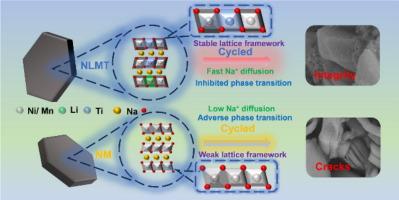Stabilizing P2-phase in layered oxides via electronic modulation for high-performance sodium-ion batteries
IF 14.9
1区 化学
Q1 Energy
引用次数: 0
Abstract
P2-type layered oxides are highly promising cathode candidates for sodium-ion batteries (SIBs) owing to their substantial theoretical capacity. Nevertheless, structural degradation caused by transition metal dissolution and irreversible phase transitions at high voltage severely compromises cycling stability. To address this limitation, we propose a Li/Ti co-doping strategy to design a Na0.67Li0.06Ni0.27Mn0.57Ti0.1O2 (NLMT) cathode for SIBs. In-situ X-ray diffraction (XRD) confirms that this deliberate strategy eliminates the adverse phase transition at high voltage and sustains the unitary P2 phase throughout cycling. In addition, strengthened transition metal–oxygen (TM–O) bonding via electronic modulation suppresses transition metal dissolution and reinforces the layered oxide framework, contributing to exceptional electrochemical performance. Consequently, the NLMT cathode exhibits an outstanding capacity of 92.8 mA h g−1 within 2.5–4.3 V at 5 C (865 mA g−1), with 87 % capacity retention over 200 cycles. Configured into a full cell, which achieves a competitive capacity of 107.7 mA h g−1 at 0.1 C and retains 86.4 % capacity over 100 cycles at 0.5 C. This study validates co-doping as a potent strategy for significantly improving the long-term cyclability of layered oxide cathodes in SIBs.

通过电子调制稳定层状氧化物中的p2相用于高性能钠离子电池
p2型层状氧化物由于其可观的理论容量,是钠离子电池极有前途的阴极候选者。然而,由过渡金属溶解和高压下不可逆相变引起的结构退化严重影响循环稳定性。为了解决这一限制,我们提出了一种Li/Ti共掺杂策略来设计用于sib的Na0.67Li0.06Ni0.27Mn0.57Ti0.1O2 (NLMT)阴极。原位x射线衍射(XRD)证实,这种精心设计的策略消除了高压下的不利相变,并在整个循环过程中保持了统一的P2相。此外,通过电子调制加强过渡金属-氧(TM-O)键合,抑制过渡金属溶解,强化层状氧化物框架,有助于实现优异的电化学性能。因此,NLMT阴极在2.5-4.3 V, 5c (865 mA g - 1)下表现出92.8 mA h g - 1的出色容量,在200次循环中保持87%的容量。配置成一个完整的电池,在0.1 C下达到107.7 mA h g−1的竞争容量,在0.5 C下100次循环保持86.4%的容量。这项研究验证了共掺杂是一种有效的策略,可以显着提高sib层状氧化物阴极的长期循环能力。
本文章由计算机程序翻译,如有差异,请以英文原文为准。
求助全文
约1分钟内获得全文
求助全文
来源期刊

Journal of Energy Chemistry
CHEMISTRY, APPLIED-CHEMISTRY, PHYSICAL
CiteScore
19.10
自引率
8.40%
发文量
3631
审稿时长
15 days
期刊介绍:
The Journal of Energy Chemistry, the official publication of Science Press and the Dalian Institute of Chemical Physics, Chinese Academy of Sciences, serves as a platform for reporting creative research and innovative applications in energy chemistry. It mainly reports on creative researches and innovative applications of chemical conversions of fossil energy, carbon dioxide, electrochemical energy and hydrogen energy, as well as the conversions of biomass and solar energy related with chemical issues to promote academic exchanges in the field of energy chemistry and to accelerate the exploration, research and development of energy science and technologies.
This journal focuses on original research papers covering various topics within energy chemistry worldwide, including:
Optimized utilization of fossil energy
Hydrogen energy
Conversion and storage of electrochemical energy
Capture, storage, and chemical conversion of carbon dioxide
Materials and nanotechnologies for energy conversion and storage
Chemistry in biomass conversion
Chemistry in the utilization of solar energy
 求助内容:
求助内容: 应助结果提醒方式:
应助结果提醒方式:


